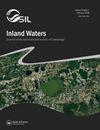High-frequency monitoring enables operational opportunities to reduce the dissolved organic carbon (DOC) load in Germany’s largest drinking water reservoir
IF 2.3
3区 环境科学与生态学
Q1 LIMNOLOGY
引用次数: 1
Abstract
ABSTRACT Rising dissolved organic carbon (DOC) is interfering with drinking water production. While strategies for DOC removal during water treatment have been successfully implemented, the potential for DOC load reduction by optimized reservoir operation is not yet fully explored, mainly constrained by data paucity on real-time DOC dynamics. In this study, we utilized the emerging in situ high-frequency (HF) monitoring technique for DOC and developed a simulation–operation framework that promotes DOC mitigation in Germany’s largest drinking water reservoir. Rappbode Reservoir is embedded in a network of smaller upstream reservoirs from which Königshütte Reservoir delivers the most water but can also be operated as a bypass system. Using high-frequency monitoring of DOC concentrations and discharge at the inflows and outflows, we constructed a mass balance model that simulated the DOC dynamics in the reservoir, allowing us to explore alternative operation regimes that deliver the same amount of water but a lower DOC load. Our results show that, through rapid decision-making that enables bypassing of water with high DOC concentrations around the drinking water reservoir, the optimized operation regime is able to reduce DOC load of the drinking water reservoir by 25 ± 3%. Therefore, our proposed operational strategy to minimize DOC loading to reservoirs is promising.高频监测为降低德国最大的饮用水水库的溶解有机碳(DOC)负荷提供了操作机会
摘要溶解性有机碳(DOC)的增加正在干扰饮用水的生产。虽然水处理过程中的DOC去除策略已经成功实施,但通过优化水库运行降低DOC负荷的潜力尚未得到充分探索,主要受到实时DOC动态数据匮乏的限制。在这项研究中,我们利用了新兴的DOC现场高频(HF)监测技术,并开发了一个模拟操作框架,以促进德国最大饮用水水库的DOC缓解。Rapbode水库嵌入了一个较小的上游水库网络中,Königshütte水库从中输送了最多的水,但也可以作为旁路系统运行。通过对流入和流出处的DOC浓度和排放进行高频监测,我们构建了一个模拟水库中DOC动态的质量平衡模型,使我们能够探索输送相同水量但DOC负荷较低的替代运行模式。我们的研究结果表明,通过快速决策,绕过饮用水蓄水池周围DOC浓度高的水,优化的运行方案能够将饮用水蓄水池的DOC负荷减少25 ± 3%。因此,我们提出的将DOC装载量降至最低的操作策略是有希望的。
本文章由计算机程序翻译,如有差异,请以英文原文为准。
求助全文
约1分钟内获得全文
求助全文
来源期刊

Inland Waters
LIMNOLOGY-MARINE & FRESHWATER BIOLOGY
CiteScore
6.10
自引率
9.70%
发文量
34
审稿时长
>12 weeks
期刊介绍:
Inland Waters is the peer-reviewed, scholarly outlet for original papers that advance science within the framework of the International Society of Limnology (SIL). The journal promotes understanding of inland aquatic ecosystems and their management. Subject matter parallels the content of SIL Congresses, and submissions based on presentations are encouraged.
All aspects of physical, chemical, and biological limnology are appropriate, as are papers on applied and regional limnology. The journal also aims to publish articles resulting from plenary lectures presented at SIL Congresses and occasional synthesis articles, as well as issues dedicated to a particular theme, specific water body, or aquatic ecosystem in a geographical area. Publication in the journal is not restricted to SIL members.
 求助内容:
求助内容: 应助结果提醒方式:
应助结果提醒方式:


